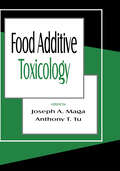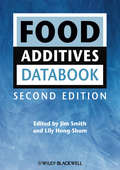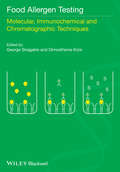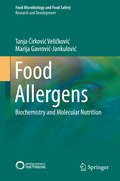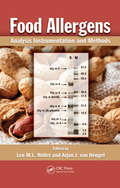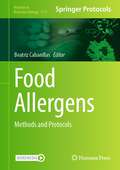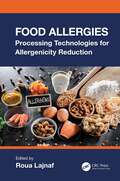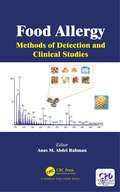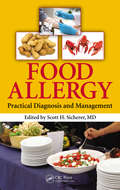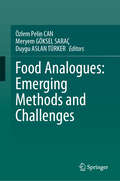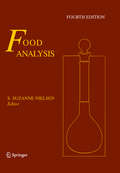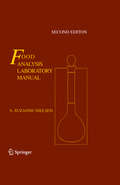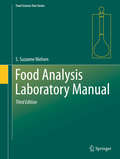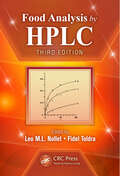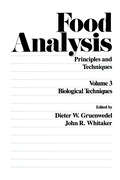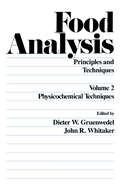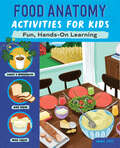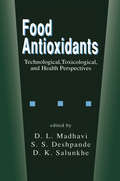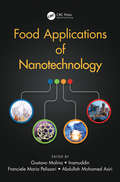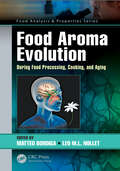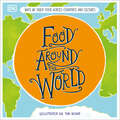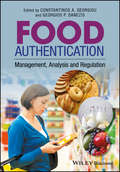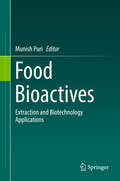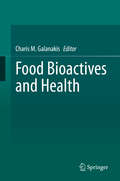- Table View
- List View
Food Additive Toxicology
by Joseph A. Maga Anthony Y. Tu"Provides both historical information and the latest toxicological data on various classes of food additives--examining the production, application, and safety of numerous compounds used to enhance and preserve the quality of foods."
Food Additives Data Book
by Jim Smith Lily Hong-ShumThe use of additives in food is a dynamic one, as consumers demand fewer additives in foods and as governments review the list of additives approved and their permitted levels. Scientists also refine the knowledge of the risk assessment process as well as improve analytical methods and the use of alternative additives, processes or ingredients. Since the first edition of the Food Additives Databook was published, there have been numerous changes due to these developments and some additives are no longer permitted, some have new permitted levels of use and new additives have been assessed and approved. The revised second edition of this major reference work covers all the "must-have" technical data on food additives. Compiled by food industry experts with a proven track record of producing high quality reference work, this volume is the definitive resource for technologists in small, medium and large companies, and for workers in research, government and academic institutions. Coverage is of Preservatives, Enzymes, Gases, Nutritive additives, Emulsifiers, Flour additives, Acidulants, Sequestrants, Antioxidants, Flavour enhancers, Colour, Sweeteners, Polysaccharides, Solvents. Entries include information on: Function and Applications, Safety issues, International legal issues, Alternatives, Synonyms, Molecular Formula and mass, Alternative forms, Appearance, Boiling, melting, and flash points, density, purity, water content, solubility, Synergists, Antagonists, and more with full and easy-to-follow-up references. Reviews of the first edition: "Additives have their advantages for the food industry in order to provide safe and convenient food products. It is therefore essential that as much information as possible is available to allow an informed decision on the selection of an additive for a particular purpose. This data book provides such information - consisting of over 1000 pages and covering around 350 additives. This data book does provide a vast amount of information; it is what it claims to be! Overall, this is a very useful publication and a good reference book for anyone working in the food and dairy industry." —International Journal of Dairy Technology, Volume 59 Issue 2, May 2006 "This book is the best I have ever seen ... a clear winner over all other food additive books .... a superb edition." —SAAFOST (South African Association for Food Science and Technology)
Food Allergen Testing: Molecular, Immunochemical and Chromatographic Techniques
by Dimosthenis Kizis George SiragakisAn in-depth review of the current scientific knowledge on food allergens testing, covering the major methodologies and techniques used to detect food allergens. Food allergens are a series of agents, mainly proteins, which cause various unpleasant and sometimes clinical symptoms in humans through consumption of foods. Perhaps surprisingly, there are no treatments against food allergies which have been found to be 100% effective. The scope for individual difference in terms of how a person reacts to a given allergen is massive, making it incredibly difficult and complex to try and medicate against allergies. Food Allergens Testing takes a thorough look at modern molecular biology and immunochemical techniques used to detect food allergens. The eleven chapters constitute an in-depth review of the current scientific knowledge on food allergens, covering the major methodologies and techniques used in validated analytical approaches. The book is aimed at scientists and technical staff in the food industry and analytical laboratories who need an up-to-date treatment of both fundamental and applied research goals on food allergens, as well as a report on the validated methods currently in use for food allergens testing.
Food Allergens
by Tanja Ćirković Veličković Marija Gavrović-JankulovićA food allergen has the ability to first elicit an IgE response, and then, on subsequent exposures, a clinical response to the same or similar protein. How harmless food protein becomes recognized by the mucosal immune system as an allergen remains an open question and more data are needed to explain how regulatory mechanisms of the mucosal immune system fail and result in allergic sensitization to dietary antigens. Some biochemical characteristics associated with food allergens, such as the presence of multiple, linear IgE-binding epitopes and the resistance of the protein to digestion and processing, seem to predominate among food allergens. Digestion susceptibility of food allergens that sensitize via the gastrointestinal tract and stability to food processing conditions are inherently related to protein structural features. Thereby, physiological changes in the digestion process, pathological conditions affecting digestion, as well as procedures and food processing conditions that affect protein structure may all have a profound effect on the sensitizing potential and allergenicity of food proteins. In addition, signals coming from the diet and micro biome can modulate regulatory mechanisms of the mucosal immune system and influence mucosal immunity and intestinal barrier function. The detection of allergenic ingredients in food products has received increased attention from the food industry and legislative and regulatory agencies over recent years. This has resulted in the improvement of applied safety measures that provide protection for food-allergic consumers and development of sensitive and highly specific analytical methods of food allergens detection. Food allergy is an important and common health issue and therefore there is a need to characterize the sensitizing potential of newly introduced proteins in genetically engineered foods. A combination of in vitro and in silico methods provide information that contributes to safety assessment. Suitable in vivo models may provide a more holistic assessment of allergenic potential of novel food proteins.
Food Allergens: Analysis Instrumentation and Methods
by Leo M.L. Nollet Arjon J. van HengelWhile there are many books about various aspects of food allergy and allergens, not many comprehensively review the wide range of instrumentation and methods used in this analysis. Covering all of the major recognized food allergens in the US and EU, Food Allergens: Analysis Instrumentation and Methods begins with an introduction to the problem and
Food Allergens: Methods and Protocols (Methods in Molecular Biology #2717)
by Beatriz CabanillasThis detailed volume provides a comprehensive collection of methods and protocols in food allergy and food allergens studies. The selected protocols explore the study of food allergens, from recombinant production, purification procedures, IgE and T cell epitopes characterization, to allergen structure description, cellular responses, and tolerance induction, through a variety of techniques and animal models. Written for the highly successful Methods in Molecular Biology series, chapters include introductions to their respective topics, lists of the necessary materials and reagents, step-by-step and readily reproducible laboratory protocols, as well as tips on troubleshooting and avoiding known pitfalls. Authoritative and practical, Food Allergens: Methods and Protocols serves as an ideal reference for scientists at all stages involved in the study of food allergy and allergenic components.
Food Allergies: Processing Technologies for Allergenicity Reduction
by Roua LajnafMuch has been written about food allergies in scientific journals and in the lay press, but Food Allergies: Processing Technologies for Allergenicity Reduction approaches the issue of food allergies from an industrial processing rather than a clinical perspective.Indeed, industrial food processing technologies can have many beneficial effects to obtain various food products and to preserve foods from physical, chemical and microbiological alterations. However, processing technologies, including thermal and non‑thermal technologies, can also alter the allergenic properties of food proteins.This book provides an authoritative source of information on the relationship between food processing technologies and food allergens with a greater variety of studied allergens including peanuts, tree nuts, cow’s milk, eggs, sesame, lupine, soy, wheat, mustard, mushroom, fish and shellfish, as well as the importance of processing these when producing hypoallergenic foods.Key Features: Presents food allergies with recent advances and statistics concerning prevalence, physiopathologic mechanism, diagnosis and anaphylaxis Discusses food allergies in the food industry and investigates the effect of processing on allergenicity of foods during manufacturing Provides food processing and promising technologies to produce hypoallergenic food with high quality Covers the allergenic effect of different food additives with an investigation of cross‑reaction risks This unique book is an indispensable guide for allergic patients, production managers, scientists and nutritionists within the food industry as well as covering a range of critical topics in this area for all those concerned with understanding and managing food allergies.
Food Allergy: Methods of Detection and Clinical Studies
by Anas RahmanThis book explores the recent advances and integrations in molecular technology in food research platforms, which have revolutionized the way we discover and trace potential allergens in our food and drugs and how we utilize that for diagnosis and management. These different technologies for global allergenomic profiling in different kinds of food are discussed, including mass spectrometry, chromatography, and nuclear magnetic resonance. The book also addresses multiomics research with bioinformatics strategies in food allergy in terms of allergen characterization and quantitation, and covers applications in food allergy research from discovery to routine analysis.
Food Allergy: Practical Diagnosis and Management
by Scott H. SichererFood allergy has increased over the past two decades, with a larger number of patients presenting a myriad of related symptoms and illnesses to physicians and allied health professionals. The growing number of patients poses a challenge to health care providers and confirms the need for developing best clinical practice guidelines. Based on the Exp
Food Analogues: Emerging Methods and Challenges
by Özlem Pelin Can Meryem Göksel Saraç Duygu Aslan TürkerAs vegetarian and vegan diets have taken hold across the Western world in recent years, the food industry has in turn seen a burgeoning demand for plant-based substitutes, known as analogues. Consumers are hungry for a product that aligns with their values, meets their nutritional needs, and also delivers on its promise of simulating the qualities of its target food item, be that beef, chicken, egg or dairy. Researchers are thus continually working to more closely approximate not only the taste but also the aesthetic, textural and rheological properties of the food item they are imitating. Meanwhile, questions about the nutritional content and environmental impact of food analogues are also of major interest for conscious consumers. While existing volumes have covered specific analogues such as meat or dairy, Food Analogues: Emerging Methods and Challenges will be the first to offer an authoritative overview of all food analogues and comprehensively assess the current and future state of the industry. This text covers both the fundamental processes of textural manipulation and sensory evaluation as well as the microbiological and regulatory aspects of these plant-based substitutes. Looking towards the future of food analogue technology, it will also discuss promising new approaches such as the use of 3D printing and edible insects in analogue production. This book will be of value to researchers, manufacturers, regulators, nutritionists, and even consumers themselves, seeking to make more informed decisions about their diets.
Food Analysis
by S. Suzanne NielsenThis book provides information on the techniques needed to analyze foods in laboratory experiments. All topics covered include information on the basic principles, procedures, advantages, limitations, and applications. This book is ideal for undergraduate courses in food analysis and is also an invaluable reference to professionals in the food industry. General information is provided on regulations, standards, labeling, sampling and data handling as background for chapters on specific methods to determine the chemical composition and characteristics of foods. Large, expanded sections on spectroscopy and chromatography also are included. Other methods and instrumentation such as thermal analysis, ion-selective electrodes, enzymes, and immunoassays are covered from the perspective of their use in the analysis of foods. A website with related teaching materials is accessible to instructors who adopt the textbook.
Food Analysis (Food Science Text Series)
by S. Suzanne NielsenThis fifth edition provides information on techniques needed to analyze foods for chemical and physical properties. The book is ideal for undergraduate courses in food analysis and is also an invaluable reference to professionals in the food industry. General information chapters on regulations, labeling, sampling, and data handling provide background information for chapters on specific methods to determine chemical composition and characteristics, physical properties, and objectionable matter and constituents. Methods of analysis covered include information on the basic principles, advantages, limitations, and applications. Sections on spectroscopy and chromatography along with chapters on techniques such as immunoassays, thermal analysis, and microscopy from the perspective of their use in food analysis have been expanded. Instructors who adopt the textbook can contact the editor for access to a website with related teaching materials.
Food Analysis Laboratory Manual
by S. Suzanne NielsenThis second edition laboratory manual was written to accompany Food Analysis, Fourth Edition, ISBN 978-1-4419-1477-4, by the same author. The 21 laboratory exercises in the manual cover 20 of the 32 chapters in the textbook. Many of the laboratory exercises have multiple sections to cover several methods of analysis for a particular food component of characteristic. Most of the laboratory exercises include the following: introduction, reading assignment, objective, principle of method, chemicals, reagents, precautions and waste disposal, supplies, equipment, procedure, data and calculations, questions, and references. This laboratory manual is ideal for the laboratory portion of undergraduate courses in food analysis.
Food Analysis Laboratory Manual (Food Science Text Series)
by S. Suzanne NielsenThis third edition laboratory manual was written to accompany Food Analysis, Fifth Edition, by the same author. New to this third edition of the laboratory manual are four introductory chapters that complement both the textbook chapters and the laboratory exercises. The 24 laboratory exercises in the manual cover 21 of the 35 chapters in the textbook. Many of the laboratory exercises have multiple sections to cover several methods of analysis for a particular food component of characteristic. Most of the laboratory exercises include the following: background, reading assignment, objective, principle of method, chemicals, reagents, precautions and waste disposal, supplies, equipment, procedure, data and calculations, questions, and references. This laboratory manual is ideal for the laboratory portion of undergraduate courses in food analysis.
Food Analysis by HPLC
by Fidel Toldrá Leo M.L. NolletFor food scientists, high-performance liquid chromatography (HPLC) is a powerful tool for product composition testing and assuring product quality. Since the last edition of this volume was published, great strides have been made in HPLC analysis techniques-with particular attention given to miniaturization, automatization, and green chemistry. Tho
Food Analysis: Principles and Techniques (In 4 Volumes)
by John R. Whitaker Dieter W. GruenwedelThis book describes a number of biological techniques that are of vital importance to the quality and safety assessment of foods, particularly in the areas of nutrition and food toxicology. It contains examples of the application of the principles in the analysis of compounds of interest in foods.
Food Analysis: Principles and Techniques (In 4 Volumes)
by GruenwedelWith advances in techniques and technology coupled with the growing need to deal withthe problems associated with quality assurance, product development, and food safety,the science of food analysis has developed rapidly in recent years. Food Analysis: Principlesand Techniques provides an unparalleled source of information for all aspects of thisfield, filling your needs for up-to-date, detailed treatment of the methods of food analysis.Volume 2 of this important 8-volume treatise focuses on essential physicochemical techniques,ranging from the measurement of physical parameters, such as temperature, solubility,and viscosity, to the determination of food components at the supramolecular andatomic levels. Incorporating the latest developments in instrumentation that facilitate rapid,quantitative analysis, Physicochemical Techniques assures you comprehensive, accuratecoverage that you can turn to time and time again.Consolidating the expertise of renowned international authorities, Food Analysis: Principlesand Techniques serves as the complete, state-of-the-art reference and the basis forcontinuing development. For all food analysts in industry, government, and academiaincludingfood scientists, chemists, biochemists, nutritionists, environmental chemists,and microbiologists-this major resource will be the standard by which other works arecompared . Also, graduate students in food science and nutrition will find each volume ofthis work indispensable in their studies.
Food Anatomy Activities for Kids: Fun, Hands-On Learning (Anatomy Activities for Kids)
by Amber K. StottA hands-on guide to the world of food science for kids ages 8 to 12 The meal on your plate has had many adventures on its way to your belly! Uncover the mysteries of the food you eat with Food Anatomy Activities for Kids, a kids' guide to the incredible history, science, and culture of food. It's packed with easy-to-understand lessons, fun recipes, and engaging experiments to make you feel connected to the food you eat—and make your mouth happy! Travel on a food journey around the world, taste new things, and learn fun facts. Find out all about foods that are foraged or farmed, sweet or savory, baked or preserved—and don't forget foods that you drink! Get involved by predicting the answers to questions, testing your ideas, and drawing conclusions just like a real food scientist. Inside Food Anatomy Activities for Kids, you'll: Follow the life of food—Discover colorfully illustrated lessons on the history and uses of 20 different types of foods. Try awesome activities—Dive into cool experiments like preserving egg yolks with salt, making butter in a mason jar, and growing new fruit from leftover seeds. Think like a scientist—Grab your own notebook and write down your discoveries with the help of in-depth journal prompts after every activity. Take a trip through the wonderful world of food with Food Anatomy Activities for Kids!
Food Antioxidants: Technological: Toxicological and Health Perspectives
by S.S. Deshpande D.L. Madhavi D.K. Salunkhe"Offers comprehensive coverage of the latest toxicological, technological, and nutritional developments in both natural and synthetic antioxidants used in the food industry. Explores the sources of antioxidants, antioxidant classification, synergism, degradation in food systems, and techniques for identification."
Food Applications of Nanotechnology
by Gustavo Molina Inamuddin Franciele Maria Pelissari Abdullah Mohamed AsiriNanotechnology has developed remarkably in recent years and, applied in the food industry, has allowed new industrial advances, the improvement of conventional technologies, and the commercialization of products with new features and functionalities. This progress offers the potential to increase productivity for producers, food security for consumers and economic growth for industries. Food Applications of Nanotechnology presents the main advances of nanotechnology for food industry development. The fundamental concepts of the technique are presented, followed by examples of application in several sectors, such as the enhancement of flavor, color and sensory characteristics; the description of the general concepts of nano-supplements, antimicrobial nanoparticles and other active compounds into food; and developments in the field of packaging, among others. In addition, this work updates readers on the industrial development and the main regulatory aspects for the safety and commercialization of nanofoods. Features: Provides a general overview of nanotechnology in the food industry Discusses the current status of the production and use of nanomaterials as food additives Covers the technological developments in the areas of flavor, color and sensory characteristics of food and food additives Reviews nanosupplements and how they provide improvements in nutritional functionality Explains the antibacterial properties of nanoparticles for food applications This book will serve food scientists and technologists, food engineers, chemists and innovators working in food or ingredient research and new product development. Gustavo Molina is associate professor at the UFVJM (Diamantina—Brazil) in Food Engineering and head of the Laboratory of Food Biotechnology and conducts scientific and technical research. His research interests are focused on industrial biotechnology. Dr. Inamuddin is currently working as assistant professor in the chemistry department of Faculty of Science, King Abdulaziz University, Jeddah, Saudi Arabia. He is also a permanent faculty member (assistant professor) at the Department of Applied Chemistry, Aligarh Muslim University, Aligarh, India. He has extensive research experience in multidisciplinary fields of analytical chemistry, materials chemistry, and electrochemistry and, more specifically, renewable energy and environment. Prof. Abdullah M. Asiri is professor of organic photochemistry and has been the head of the chemistry department at King Abdulaziz University since October 2009, as well as the director of the Center of Excellence for Advanced Materials Research (CEAMR) since 2010. His research interest covers color chemistry, synthesis of novel photochromic and thermochromic systems, synthesis of novel coloring matters and dyeing of textiles, materials chemistry, nanochemistry and nanotechnology, polymers, and plastics. Franciele Maria Pelissari graduated in Food Engineering; earned her master’s degree (2009) at the University of Londrina (UEL), Londrina, Brazil; and her PhD (2013) at the University of Campinas (Unicamp), Campinas, Brazil. Since 2013, she has been associate professor at the Institute of Science and Technology program at the Federal University of Jequitinhonha and Mucuri (UFVJM), Diamantina, Brazil, in Food Engineering, and also full professor in the graduate program in Food Science and Technology.
Food Aroma Evolution: During Food Processing, Cooking, and Aging (Food Analysis & Properties)
by Matteo Bordiga, Leo M.L. NolletOf the five senses, smell is the most direct and food aromas are the key drivers of our flavor experience. They are crucial for the synergy of food and drinks. Up to 80% of what we call taste is actually aroma. Food Aroma Evolution: During Food Processing, Cooking, and Aging focuses on the description of the aroma evolution in several food matrices. Not only cooking, but also processing (such as fermentation) and aging are responsible for food aroma evolution. A comprehensive evaluation of foods requires that analytical techniques keep pace with the available technology. As a result, a major objective in the chemistry of food aroma is concerned with the application and continual development of analytical methods. This particularly important aspect is discussed in depth in a dedicated section of the book. Features Covers aromatic evolution of food as it is affected by treatment Focuses on food processing, cooking, and aging Describes both classic and new analytical techniques Explains how the flavor perception results are influenced by other food constituents The book comprises a good mix of referenced research with practical applications, also reporting case studies of these various applications of novel technologies. This text represents a comprehensive reference book for students, educators, researchers, food processors, and food industry personnel providing an up-to-date insight. The range of techniques and materials covered provides engineers and scientists working in the food industry with a valuable resource for their work. Also available in the Food Analysis & Properties Series: Ambient Mass Spectroscopy Techniques in Food and the Environment, edited by Leo M.L. Nollet and Basil K. Munjanja (ISBN: 9781138505568) Hyperspectral Imaging Analysis and Applications for Food Quality, edited by N.C. Basantia, Leo M.L. Nollet, and Mohammed Kamruzzaman (ISBN: 9781138630796) Fingerprinting Techniques in Food Authentication and Traceability, edited by Khwaja Salahuddin Siddiqi and Leo M.L. Nollet (ISBN: 9781138197671) For a complete list of books in this series, please visit our website at: www.crcpress.com/Food-Analysis--Properties/book-series/CRCFOODANPRO
Food Around the World (DK Around the World)
by DKIntroduce young readers to a variety of countries and cultures through an exploration of food.Discover fascinating facts about the food on your plate and tasty dishes from all around the world in this educational reader to help children aged 7-9 learn about countries and cultures.Children can explore the significance of food to different cultures and the variety of ways in which food is prepared and shared. Then learn how diet can vary according to personal choice, culture, and medical needs, and how food can be broken down into groups to help us maintain a healthy, balanced diet.The educational series can help children learn about the world, with:Links to key social studies and geography curriculum objectives. Content that allows children to learn about a variety of countries, cultures, and celebrations through food and its significance to each country and culture.Recipes featured that are simple and easy to follow for young readers to try out. Food Around the World follows the journey of food from farm to table, learning how seasons can affect what produce is available. Children can learn how food is packaged, and how to recycle packaging and reduce food waste. Plus, fun food facts show how food can be grown to extremes! About the seriesThis book is part of the …Around the World series, which includes Celebrations Around the World and Language Around the World. The series is designed to inspire and inform children with bright and original illustrations and fascinating facts about the world around us.
Food Authentication: Management, Analysis and Regulation
by Constantinos A. Georgiou Georgios P. DanezisThe determination of food authenticity is a vital component of quality control. Its importance has been highlighted in recent years by high-profile cases in the global supply chain such as the European horsemeat scandal and the Chinese melamine scandal which led to six fatalities and the hospitalisation of thousands of infants. As well as being a safety concern, authenticity is also a quality criterion for food and food ingredients. Consumers and retailers demand that the products they purchase and sell are what they purport to be. This book covers the most advanced techniques used for the authentication of a vast number of products around the world. The reader will be informed about the latest pertinent analytical techniques. Chapters focus on the novel techniques & markers that have emerged in recent years. An introductory section presents the concepts of food authentication while the second section examines in detail the analytical techniques for the detection of fraud relating to geographical, botanical, species and processing origin and production methods of food materials and ingredients. Finally, the third section looks at consumer attitudes towards food authenticity, the application of bioinformatics to this field, and the Editor’s conclusions and future outlook. Beyond being a reference to researchers working in food authentication it will serve as an essential source to analytical scientists interested in the field and food scientists to appreciate analytical approaches. This book will be a companion to under- and postgraduate students in their wander in food authentication and aims to be useful to researchers in universities and research institutions.
Food Bioactives
by Munish PuriThis book focuses on various types of bioactive compounds, including secondary metabolites, oligosaccharides, polysaccharides, flavonoids, peptides/proteins, carotenoid pigments, quinones, terpenes, and polyunsaturated fatty acids, and presents an overview of their nutraceutical activities. It covers the current status and future potential of food compounds, as well as extraction technologies for bioactives derived from plant, fungi and marine-derived bioactive agents. Finally, health-promoting effects of plant, fungi and marine-derived bioactive agents are discussed. Chapters come from top researchers in this area from around the globe. The volume caters to the needs of undergraduate and post-graduate students in the area of food biotechnology, food bioprocessing, biotechnology, food engineering, etc. , and also contains information pertinent to researchers.
Food Bioactives and Health (Food Bioactive Ingredients Ser.)
by Charis M. GalanakisBioactive natural compounds have gained attention in recent years due to their potential health benefits, including reducing the risk of diabetes, cancer, and cardiovascular diseases. These benefits derive from bioactive compounds' anti-tumor, anti-inflammatory, anti-oxidative, anti-hypertensive and anti-hyperlipidemic activities, which serve in addition to their basic nutritional functions. Over the last decade, researchers have investigated the health impact of bioactive compounds in detail, and the development of food applications has attracted great interest. Consumer demand has surged for functional foods (nutraceuticals), superfoods, and tailor-made foods, generated by supplementing traditional food products with bioactive ingredients. Food Bioactives and Health offers comprehensive coverage of the properties and health effects of food bioactives in view of new trends in processing, food science and food technology. Starting with the metabolic characteristics of polyphenols, glucosinolates, and other food bioactives, the text then dives into their impact on human health and recent applications in the world of food technology. For food scientists, food technologists, and product developers looking to understand the role of food bioactives in health and develop applications in personalized nutrition, functional foods and nutraceuticals, Food Bioactives and Health serves as a one-stop reference.
